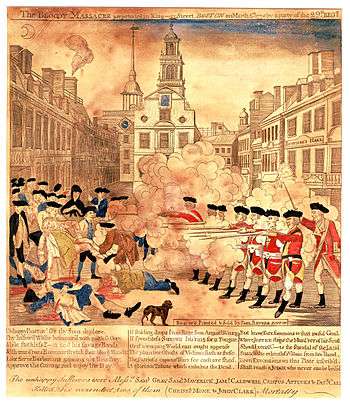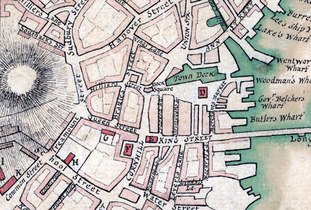State Street (Boston)
State Street in Boston, Massachusetts, is one of the oldest streets in the city. Located in the financial district, it is the site of some historic landmarks, such as Long Wharf, the Old State House and the Boston Custom House.

History

In 1630 the first Puritan settlers, led by John Winthrop, built their earliest houses along what is today "State Street." The Puritans also originally built the meeting house for the First Church in Boston on the street across from the marketplace, which was located where the Old State House stands today. By 1636 the thoroughfare was known as Market Street. From 1708 to 1784 it was renamed King Street. In 1770 the Boston Massacre took place in front of the Customs House.
During the Revolutionary War, it assumed its current, non-royalist name.[1] In the 19th century State Street became known as Boston's primary location for banks and other financial institutions.[2]
Transportation
The Blue Line of the MBTA subway runs below State Street. Two stations have entrances on State Street: Aquarium, and State. The Faneuil Hall Marketplace can also be found nearby. The east end of State Street is at Long Wharf, where ferries are available to several places, including the airport.
See also
Images
 John Winthrop built his first house in Boston on what is today, State Street
John Winthrop built his first house in Boston on what is today, State Street 1630 site of Winthrop's first home in Boston on State Street
1630 site of Winthrop's first home in Boston on State Street The Boston Massacre took place on State Street (then "King Street") in front of the Old State House; the site is marked by a cobblestone circle in the square
The Boston Massacre took place on State Street (then "King Street") in front of the Old State House; the site is marked by a cobblestone circle in the square Detail of 1775 map of Boston, showing King Street and vicinity
Detail of 1775 map of Boston, showing King Street and vicinity State Street, 1801, by J. Marston
State Street, 1801, by J. Marston Advertisement for Lemuel Gulliver "stationer, chart and nautical bookseller" c. 1826
Advertisement for Lemuel Gulliver "stationer, chart and nautical bookseller" c. 1826 State St., c. 19th century
State St., c. 19th century
References
- Boston Street Laying-Out Dept. A record of the streets, alleys, places, etc. in the city of Boston. Boston: City Printing Dept., 1910.
- Thomas F. Anderson. Historic Boston. New England Magazine, June 1908
Further reading
| Wikimedia Commons has media related to State Street (Boston, Massachusetts). |
- "State Street". Ballou's Pictorial. Boston, Mass. 8. 1855.
- State Street: a brief account of a Boston way. Boston: State Street Trust Company, 1906